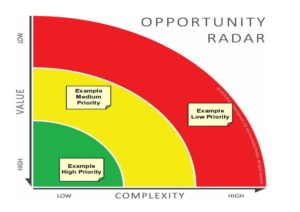 This is a guest post by Nat Greene, author of Stop Guessing: The 9 Behaviors of Great Problem-Solvers
This is a guest post by Nat Greene, author of Stop Guessing: The 9 Behaviors of Great Problem-Solvers
Business leaders face a constant burden in their organizations: They have too many problems to solve and not enough resources to solve all of them.
A good prioritization system is critical for any business leader, and our relationship with it often resembles a car. When working well, we barely notice it; when it’s broken, we’re frustrated and stuck. When our cars need repairs, we fix them quickly, usually within a few days. However, when it comes to work, we allow ourselves and our teams to suffer for long periods before taking the time to realign priorities.
It begs the question: If the problem of misaligned priorities is so easy to spot, why is it seemingly difficult to correct?
Most supervisors are managing cross-functional teams, in which group resources are deployed to solve problems in certain silos. That can create an environment in which different functions are competing for resources, and each can make a compelling case that their problem is a top priority. Such a scramble makes everything seem important and leads to two problems:
- The organization may be trying to solve too many problems at once
- The organization may pursue problems that don’t have the greatest value
You’re probably familiar with the signs of such a dilemma: long hours, juggling many projects and overlapping deadlines. You feel like you’re working all the time, but problems aren’t being solved. If they are, you’re not getting the results you expected. If you’re a supervisor that’s new to your team, you may be struggling with a “me first” attitude from most, if not all, members on your team.
Escape the misaligned priorities trap
To get better results with less effort, you need to help your team agree on which problems you will focus your resources on first. Pinpointing the three most important problems to solve will accelerate how quickly you progress and improve the results for the business. Achieving that level of consensus can be difficult, but building your team’s buy-in is a priority for any leader.
How can you achieve consensus with your team about what problems to focus on first?
- Acknowledge that prioritization means choosing what problems not to solve now. Have the courage to say “No,” to some projects or ideas, and get team members to acknowledge that resources should be deployed only to the problems that are going to create the most value for the business.
- Set aside opinions and make fact-based decisions. Use only facts to determine the priority of a problem. People often confuse someone’s opinion, anecdote or assumption for facts. Coach your employees to validate what they believe with facts they have gathered from the ground.
Using facts effectively in prioritization
Top-priority problems should be those where you get the most “bang for your buck.” The “bang” is the value of solving the problem; the “buck” is the complexity to resource the problem and implement a solution. The value of a problem is the return to the business (typically monetary, but not always) once you solve the problem.
To determine the relative value of different problems, calculate the annualized return, or some other agreed-upon metric, to the business once your resolve the issue. Those with the highest return will be the highest value.
Complex problems are those that will require plenty of time or resources to resolve. Complexity is somewhat subjective and can be determined relatively: For a given problem, will it have greater or lesser resource complexity than another? You can use the following guidelines to determine relative complexity:
- Number of resources or man hours required to implement the solution
- Cross-functionality of people involved in implementation
- Cost of implementation
- Regulatory, legal or environmental risk
- Number of problems that need to be solved to arrive at a solution
- How long it will take to implement the solution
- Number of organizational constraints that need to be overcome
Putting it all together
Because there are two criteria for prioritizing a problem, it’s a two-dimensional exercise. Should you work on a  higher-value, higher-complexity opportunity? Or a lower-value, lower-complexity one? To put it all together, you can use a resource such as an Opportunity Radar to visually map problems on both dimensions.
higher-value, higher-complexity opportunity? Or a lower-value, lower-complexity one? To put it all together, you can use a resource such as an Opportunity Radar to visually map problems on both dimensions.
Those in the “green” of highest value and lowest complexity should be resourced first. Those out in the “red” should not be resourced. As problems in the green are solved, others will move in to their place, to be resourced next.
You can learn more about using Opportunity Radars for prioritization, and download free versions for your business, here.
Effective prioritization will mean you’ll lead your team towards much faster results. Having an agreed-upon structure, the courage to say “No,” and a dedication to using only facts to prioritize different problems will go a long way to helping your business improve at the greatest possible rate. As a bonus, you’ll find yourself with fewer balls in the air, fewer late nights at work, and greater harmony in your cross-functional team meetings.
Nathaniel Greene is the co-founder and current CEO of Stroud International, and author of Stop Guessing: The 9 Behaviors of Great Problem-Solvers. Nat has a Masters of Engineering from Oxford University and studied design, manufacturing and management at Cambridge University, in addition to executive education coursework in Harvard Business School’s Owner/President Management program.
Photo Credit: http://www.freeimages.com/photo/ticked-checkbox-1245057

0 comments